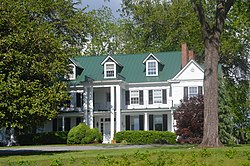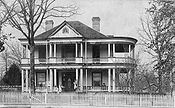
Martinsville is an independent city in the Commonwealth of Virginia in the United States. As of the 2020 census, the population was 13,485. A community of both Southside and Southwest Virginia, it is the county seat of Henry County, although the two are separate jurisdictions. The Bureau of Economic Analysis combines the city of Martinsville with Henry County for statistical purposes.

Henry County is a county located in the U.S. state of Virginia. As of the 2020 census, the population was 50,948. The county seat is usually identified as Martinsville; however, the administration building, county courthouse, and Henry County Sheriff's Office are located on Kings Mountain Road in Collinsville.The Henry County Adult Detention Center is located on DuPont Road in Martinsville.

Chatmoss is a census-designated place (CDP) in Henry County, Virginia, United States. The population was 1,698 at the 2010 census, down slightly from the 1,742 reported in 2000. It is part of the Martinsville Micropolitan Statistical Area.

Westover Plantation is a historic colonial tidewater plantation located on the north bank of the James River in Charles City County, Virginia. Established in c. 1730–1750, it is the homestead of the Byrd family of Virginia. State Route 5, a scenic byway, runs east–west to the north of the plantation, connecting the independent cities of Richmond and Williamsburg.
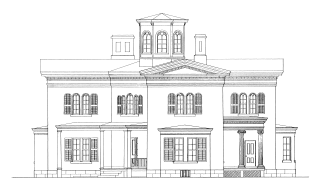
Cooleemee, also known as the Cooleemee Plantation House, is a house located between Mocksville and Lexington, North Carolina, at the terminus of SR 1812 on the Yadkin River in Davie County, North Carolina. It is a U.S. National Historic Landmark, designated in 1978 for its architecture.

Chippokes State Park is a Virginia state park on the south side of the James River on the Captain John Smith Chesapeake National Historic Trail. In addition to forests and fossil hunting on the beach, it includes three historic houses as well as an open-air agricultural and forestry museum with seasonally appropriate events. Other recreational facilities include a visitor center, swimming pool, hiking trails, cabins, yurts and campgrounds). It is located at 695 Chippokes Park Road, in rural Surry County, Virginia off Route 10.
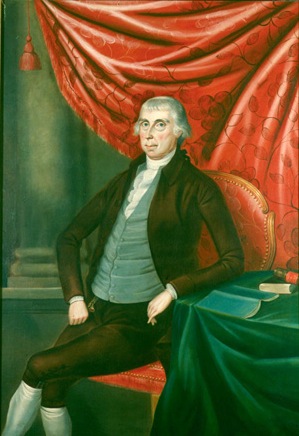
James Madison Sr. was a prominent Virginia planter and politician who served as a colonel in the Virginia militia during the American Revolutionary War. He inherited Mount Pleasant, later known as Montpelier, a large tobacco plantation in Orange County, Virginia and, with the acquisition of more property, had 5,000 acres and became the largest landowner in the county. He was the father of James Madison Jr., the 4th president of the United States, who inherited what he called Montpelier, and Lieutenant General William Taylor Madison, and great-grandfather of Confederate Brigadier General James Edwin Slaughter.

Kenmore, also known as Kenmore Plantation, is a plantation house at 1201 Washington Avenue in Fredericksburg, Virginia. Built in the 1770s, it was the home of Fielding and Betty Washington Lewis and is the only surviving structure from the 1,300-acre (530 ha) Kenmore plantation.

Bermuda Hundred was the first administrative division in the English colony of Virginia. It was founded by Sir Thomas Dale in 1613, six years after Jamestown. At the southwestern edge of the confluence of the Appomattox and James Rivers opposite City Point, annexed to Hopewell, Virginia in 1923, Bermuda Hundred was a port town for many years. The terminology "Bermuda Hundred" also included a large area adjacent to the town. In the colonial era, "hundreds" were large developments of many acres, arising from the English term to define an area which would support 100 homesteads. The port at the town of Bermuda Hundred was intended to serve other "hundreds" in addition to Bermuda Hundred.
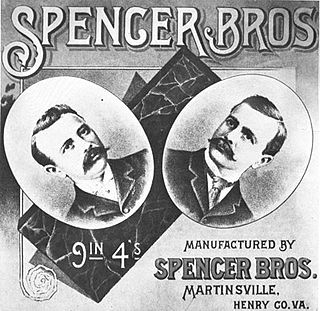
Spencer is an unincorporated community in Henry County, Virginia, United States. It takes its name from its earliest settler, James Spencer Sr., who moved from Loudoun County to Henry County with his sons in the eighteenth century. Spencer's son ensign James Spencer, Jr. died of wounds suffered during the Revolutionary War.
Ambrose Madison was an American planter and politician in the Piedmont of Virginia Colony. He married Frances Taylor in 1721, daughter of James Taylor, a member of the Knights of the Golden Horseshoe Expedition across the Blue Ridge Mountains from the Tidewater. Through her father, Madison and his brother-in-law Thomas Chew were aided in acquiring 4,675 acres in 1723, in what became Orange County. There he developed his tobacco plantation known as Mount Pleasant The Madisons were parents of James Madison Sr. and paternal grandparents of President James Madison.

Tuckahoe, also known as Tuckahoe Plantation, or Historic Tuckahoe is located in Tuckahoe, Virginia on Route 650 near Manakin Sabot, Virginia, overlapping both Goochland and Henrico counties, six miles from the town of the same name. Built in the first half of the 18th century, it is a well-preserved example of a colonial plantation house, and is particularly distinctive as a colonial prodigy house. Thomas Jefferson is also recorded as having spent some of his childhood here. It was declared a National Historic Landmark in 1969.

Plantation complexes were common on agricultural plantations in the Southern United States from the 17th into the 20th century. The complex included everything from the main residence down to the pens for livestock. Until the abolition of slavery, such plantations were generally self-sufficient settlements that relied on the forced labor of enslaved people.
Leatherwood Plantation of 10,000 acres was located in Henry County, Virginia, where American Founding Father Patrick Henry lived from 1779 until 1784. The plantation is probably named after Leatherwood Creek, a tributary to the Smith River (Virginia), which ran through the property.
Robert Hairston was an 18th-century gentleman planter, politician, and military officer in the Virginia Colony. He was an elected representative in both the House of Burgesses and the Virginia House of Delegates.
"Marrowbone" is a plantation house in Martinsville, Virginia, that may have been established in 1749. A frame house painted white, Marrowbone plantation was known widely for its hanging gardens and colonial boxwoods and cedars. John D. Rockefeller's gardeners scoured the countryside for authentic boxwoods or Buxus sempervirens for Colonial Williamsburg, and used some of the shrubs and cedars from Marrowbone for the restoration.
George Hairston was a noted planter and politician in Virginia. He was a Colonel in the American Revolutionary War and a Brigadier General in the War of 1812.
George Waller was landowner, patriot and early settler in Henry County, Virginia.

Colonel George Augustine Washington was an American tobacco planter, slaveholder, company director and politician. He was "one of the world's largest tobacco growers" by 1860, and served in the Tennessee General Assembly in the 1870s.

The planter class was a racial and socioeconomic caste which emerged in the Americas during European colonization in the early modern period. Members of the caste, most of whom were settlers of European descent, consisted of individuals who owned or were financially connected to plantations, large-scale farms devoted to the production of cash crops in high demand across Euro-American markets. These plantations were operated by the forced labour of slaves and indentured servants and typically existed in tropical climates, where the soil was fertile enough to handle the intensity of plantation agriculture. Cash crops produced on plantations owned by the planter class included tobacco, sugarcane, cotton, indigo, coffee, tea, cocoa, sisal, oil seeds, oil palms, hemp, rubber trees and fruits. In North America, the planter class formed part of the American gentry.
